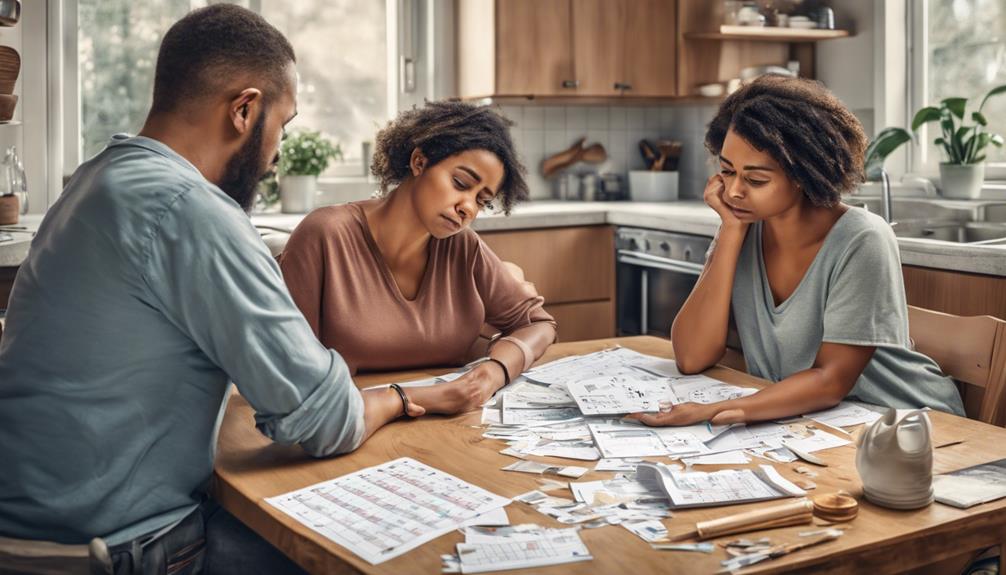We can transform our daily interactions by adopting habits that promote positive communication. Let's start with active listening—giving our undivided attention and engaging through non-verbal cues helps us connect. Showing respect by acknowledging others' viewpoints and using a considerate tone builds trust. Enhancing communication means practicing reflective listening and adapting our styles based on the conversation. Clarity matters too; speaking slowly, rephrasing for understanding, and avoiding jargon makes our message clear. Building trust involves being empathetic, transparent, and following through on promises. By integrating these practices, we create meaningful, positive interactions daily. Discover how these habits can change your conversations.
Key Takeaways
- Practice active listening by giving undivided attention and using reflective responses.
- Use positive body language such as maintaining eye contact and nodding.
- Speak clearly and use simple language to ensure understanding.
- Show respect by acknowledging different viewpoints and using a considerate tone.
- Follow through on commitments to build trust and reliability in communication.
Active Listening Techniques
Active listening requires us to fully focus on the speaker and avoid interrupting. This means we need to give our undivided attention, showing we're engaged through non-verbal cues like maintaining eye contact and nodding. These gestures signal to the speaker that we're present and interested.
Reflecting on what the speaker says before responding is another critical technique. By taking a moment to think about their words, we guarantee our comprehension of their message. We can also ask clarifying questions if something is unclear, which helps prevent misunderstandings and shows we genuinely care about their perspective.
Paraphrasing is another important skill in active listening. By restating what the speaker has said in our own words, we confirm our understanding and demonstrate respect for their thoughts. For instance, if someone shares a concern, we might say, 'So, you're feeling stressed about the upcoming exam?' This not only validates their feelings but also keeps the conversation flowing smoothly.
Showing Respect in Conversations

Respectful communication hinges on acknowledging others' viewpoints and using a considerate tone. When we engage in conversations, it's essential to demonstrate respect by actively listening and valuing the perspectives shared by others. This approach not only enhances our communication skills but also contributes to fostering trust and understanding in our interactions.
Using respectful language is key to showing respect in conversations. We should avoid being defensive and instead express our concerns with empathy. When we acknowledge others' feelings and perspectives, we validate their experiences and demonstrate that we care about what they've to say. This practice encourages open communication and strengthens our relationships.
Active listening plays an important role in respectful communication. By truly hearing what others are saying, we can respond thoughtfully and avoid misunderstandings. This helps create a safe environment where everyone feels heard and valued. Practicing these respectful communication techniques regularly can greatly enhance our communication skills, making our interactions more positive and productive.
In essence, respect in conversations is about creating a space where everyone feels respected and understood. By prioritizing active listening and using respectful language, we can foster trust and build stronger connections with those around us.
Enhancing Communication Skills

Building on the foundation of showing respect in conversations, let's explore how we can enhance our communication skills to make our interactions even more effective.
To achieve effective communication, we need to integrate several key practices into our daily routine.
- Active Listening: This means fully concentrating, understanding, responding, and remembering what's being said. By focusing on the speaker without distractions, we show that we value their words and thoughts.
- Positive Body Language: Our non-verbal cues, such as maintaining eye contact and adopting an open posture, play a significant role in communication. Positive body language reinforces our words and helps convey sincerity and engagement.
- Reflective Listening: Techniques like paraphrasing and summarizing what the speaker has said demonstrate that we're truly listening. This not only clarifies our understanding but also makes the speaker feel heard and respected.
- Adapting Communication Styles: Being aware of different communication styles and adapting to them can make our interactions smoother. Whether we're speaking with someone who prefers directness or someone who values more context, flexibility is key.
Clarity in Communication

Ensuring clarity in our communication helps us minimize misunderstandings and foster better relationships. When we communicate with clarity, we reduce the chances of conflicts and confusion. Effective communication skills are essential, and one way to achieve clarity is by speaking slowly and pausing. This allows our listeners to process what we're saying and guarantees they understand our message.
Another helpful technique is rephrasing. By repeating information in different words, we can enhance comprehension and make sure our message is clear. This is particularly important in multilingual settings, where clear communication is critical for effective understanding.
We should always aim to be concise and precise in our communication. Avoiding jargon and using simple language can make our messages more accessible. Additionally, asking for feedback or prompting our listeners to repeat back what they've understood can be a great way to check for clarity.
Building Trust Through Dialogue

As we aim for clear communication, we also need to focus on building trust through open and honest dialogue. Trust is the backbone of any strong relationship, and it's built through transparent communication and consistent actions.
When we engage in conversations, active listening and empathy are essential. By truly hearing others and understanding their perspectives, we create a safe space for honest exchanges.
To improve communication and build trust, we should adopt a few key practices:
- Practice Active Listening: Pay full attention to the speaker, acknowledge their points, and respond thoughtfully. This shows respect and fosters mutual understanding.
- Show Empathy: Put yourself in the other person's shoes. Understanding their feelings and viewpoints creates a deeper connection and trust.
- Be Transparent: Share information openly and honestly. Transparent communication helps others feel valued and trusted.
- Follow Through on Commitments: Consistency in our words and actions strengthens reliability and trustworthiness.
Frequently Asked Questions
How to Improve Communication Skills in Day-To-Day Life?
To improve our communication skills in day-to-day life, we should practice active listening, focusing on the speaker without interruptions.
Using clear, concise language helps convey our messages effectively.
Seeking feedback allows us to understand how we can improve.
Engaging in regular communication exercises or workshops enhances our skills.
Paying attention to non-verbal cues, like body language and tone of voice, gives us a more thorough understanding in conversations.
How Do You Make Communication a Habit?
To make communication a habit, we need to practice active listening daily, setting aside time for meaningful conversations. We should use positive reinforcement to encourage consistency and incorporate mindfulness into our routines.
Reflecting on our interactions helps identify areas for improvement. By doing these things regularly, we'll build strong communication habits that enhance our relationships and personal growth.
Let's make these practices part of our daily lives!
What Are the 3 Ways to Build Positive Communication?
Imagine communication as a bridge we build together.
First, let's practice active listening, giving our full attention, maintaining eye contact, and avoiding distractions.
Second, we should show empathy by acknowledging others' feelings and perspectives.
Third, we must use clear and concise language to guarantee our messages are easily understood, preventing misunderstandings.
Why Is Effective Communication Important in Daily Life?
Effective communication is essential in daily life because it helps us build strong relationships, resolve conflicts, and succeed both personally and professionally.
By being clear and concise, we avoid misunderstandings and boost productivity. Active listening, empathy, and assertiveness enhance our connections with others, leading to better mental health and emotional well-being.
Improving our communication skills makes us more self-aware, better at resolving conflicts, and more effective problem-solvers.
Conclusion
Let's make positive communication a daily habit, like watering a plant to help it grow. By practicing active listening, showing respect, enhancing our skills, maintaining clarity, and building trust, we can foster healthier relationships.
Remember, it's not about perfection, but about making consistent efforts to connect and understand one another.
Together, we can create an environment where everyone feels valued and heard, leading to stronger, more meaningful interactions every day.











